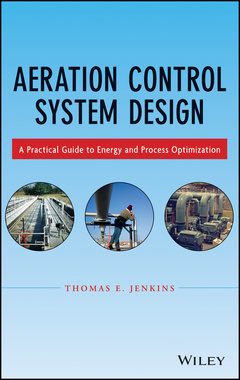Aeration Control System Design A Practical Guide to Energy and Process Optimization
Auteur : Jenkins Thomas E.

Learn how to design and implement successful aeration control systems
Combining principles and practices from mechanical, electrical, and environmental engineering, this book enables you to analyze, design, implement, and test automatic wastewater aeration control systems and processes. It brings together all the process requirements, mechanical equipment operations, instrumentation and controls, carefully explaining how all of these elements are integrated into successful aeration control systems. Moreover, Aeration Control System Design features a host of practical, state-of-the-technology tools for determining energy and process improvements, payback calculations, system commissioning, and more.
Author Thomas E. Jenkins has three decades of hands-on experience in every phase of aeration control systems design and implementation. He presents not only the most current theory and technology, but also practical tips and techniques that can only be gained by many years of experience. Inside the book, readers will find:
- Full integration of process, mechanical, and electrical engineering considerations
- Alternate control strategies and algorithms that provide better performance than conventional proportional-integral-derivative control
- Practical considerations and analytical techniques for system evaluation and design
- New feedforward control technologies and advanced process monitoring systems
Throughout the book, example problems based on field experience illustrate how the principles and techniques discussed in the book are used to create successful aeration control systems. Moreover, there are plenty of equations, charts, figures, and diagrams to support readers at every stage of the design and implementation process.
In summary, Aeration Control System Design makes it possible for engineering students and professionals to design systems that meet all mechanical, electrical, and process requirements in order to ensure effective and efficient operations.
Preface xi
Acknowledgments xiii
List of Figures xv
List of Tables xxi
1 Introduction 1
1.1 Basic Concepts and Objectives 2
1.2 Safety 9
1.3 The Importance of an Integrated Approach 10
1.4 Importance of Operator Involvement 13
1.5 The Benefits of Successful Aeration Process Automation 14
Example Problems 19
2 Initial System Assessment 21
2.1 Define Current Operations 24
2.2 Evaluate Process and Equipment 37
2.3 Benchmark Performance 40
2.4 Estimate Potential Energy Savings and Performance Improvement 42
2.5 Prepare Report 45
Example Problems 47
3 Aeration Processes 49
3.1 Process Fundamentals 49
3.2 Loading Variations and Their Implications 68
3.3 Process Limitations and Their Impact on Control Systems 70
Example Problems 74
4 Mechanical and Diffused Aeration Systems 77
4.1 Oxygen Transfer Basics 78
4.2 Types of Aerators 87
4.3 Savings Determinations 106
Example Problems 111
5 Blowers and Blower Control 113
5.1 Common Application and Selection Concerns 114
5.2 Positive Displacement Blowers and Control Characteristics 134
5.3 Dynamic Blowers 143
Example Problems 157
6 Piping Systems 161
6.1 Design Considerations 162
6.2 Pressure Drop 178
6.3 Control Valve Selection 182
Example Problems 187
7 Instrumentation 191
7.1 Common Characteristics and Electrical Design Considerations 192
7.2 Pressure 202
7.3 Temperature 205
7.4 Flow 209
7.5 Analytic Instruments 216
7.6 Motor Monitoring and Electrical Measurements 224
7.7 Miscellaneous 226
Example Problems 230
8 Final Control Elements 233
8.1 Valve Operators 234
8.2 Guide Vanes 238
8.3 Motor Basics 239
8.4 Motor Control 247
8.5 Variable Frequency Drives 251
Example Problems 259
9 Control Loops and Algorithms 261
9.1 Control Fundamentals 264
9.2 Dissolved Oxygen Control 280
9.3 Aeration Basin Air Flow Control 287
9.4 Pressure Control 288
9.5 Most-Open-Valve Control 291
9.6 Blower Control and Coordination 293
9.7 Control Loop Timing Considerations 302
9.8 Miscellaneous Controls 303
Example Problems 305
10 Control Components 309
10.1 Programmable Logic Controllers 310
10.2 Distributed Control Systems 323
10.3 Human Machine Interfaces 323
10.4 Control Panel Design Considerations 328
Example Problems 330
11 Documentation 333
11.1 Specification Considerations 335
11.2 Data Lists 338
11.3 Process and Instrumentation Diagrams 341
11.4 Ladder and Loop Diagrams 342
11.5 One-Line Diagrams 344
11.6 Installation Drawings 345
11.7 Loop Descriptions 347
11.8 Operation and Maintenance Manuals 348
Example Problems 349
12 Commissioning 351
12.1 Inspection 354
12.2 Testing 357
12.3 Tuning 361
12.4 Training 365
12.5 Measurement and Verification of Results 368
Example Problems 369
13 Summary 371
13.1 Review of Integrated Design Procedure 371
13.2 Potential Problem Areas 374
13.3 Benefits 375
Example Problems 375
Appendix A: Example Problem Solutions 377
Appendix B: List of Equations and Variables 447
Bibliography 485
Index 487
THOMAS E. JENKINS, PE, is an owner and President of JenTech Inc., where he provides consultation services to the wastewater treatment industry, including control systems, aeration systems, energy conservation, blower systems, and process equipment design. He also cofounded Energy Strategies Corporation in 1984. Mr. Jenkins is a Professor of Practice in the Department of Civil and Environmental Engineering at the University of Wisconsin-Madison. He also teaches water and wastewater treatment classes in the University's Department of Engineering Professional Development.
Date de parution : 12-2013
Ouvrage de 514 p.
16.5x24.1 cm


